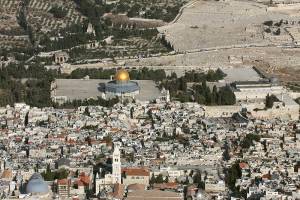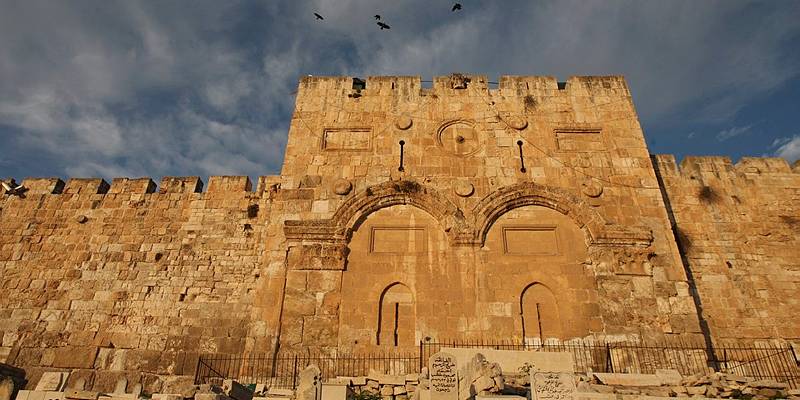The Golden Gate – ‘Shaar Rachamim’ in Hebrew, meaning Gate of Mercy – is the only one of the eight gates to the Old City of Jerusalem that is sealed and not well-frequented. However, it has a rich history and, according to Jewish tradition, will play a key role in the future.
In my last column I discussed Jaffa Gate, one of the eight entryways to the Old City of Jerusalem and perhaps the most important one. While there are eight gates, in fact only seven are functional and open. There is one gate that is sealed without access to the Old City, namely, the Golden Gate. Let’s explore the history of this gate.
There are many high vantage points outside the Old City that give a wonderful bird’s eye view of what lies within. One such popular spot is the Rehavam Lookout at the top of the Mount of Olives. The lookout is on the eastern side of the Old City, so one can see clearly from east to west. From this spot one can easily see the Kidron Valley (mentioned many times in the Bible) below, the eastern wall of the Old City, and the area of the Temple Mount where both Jewish temples had stood for a total of nearly 1000 years. Today, standing on the site of the Holy Temple is a mosque known as Al-Aqsa (the silver-domed Mosque) and the Dome of the Rock, which is a large, golden-domed edifice built by the Moslems on the spot believed to be where the Holy of Holies (the most sacred area of the Jewish temple) was located. What can also clearly seen from here is the sealed Golden Gate. One can appreciate that this gate provided entry to the Old City in general and, more important, to the Temple Mount in particular.
The name Golden Gate stems from Christian literature. In Jewish writings it is called Shaar Rachamim (Gate of Mercy). This is the gate that is closest to the Temple Mount, and hence Jews would pray by this gate, where they felt very close to the Divine Presence.

Aerial view of the Old City of Jerusalem. (Yossi Zamir/Flash 90)
In Talmudic literature the gate is also known as the Shushan Gate due to its eastern direction toward the Persian city of Shushan (located in modern-day Iran), or perhaps it earned this name because of the important role played by the Persian leader Cyrus in permitting the Jews to return to Jerusalem in the 6th century BCE to rebuild the Temple.
There is a school of Jewish thought stating that when the Messiah arrives, he will enter Jerusalem through the Eastern Gate (aka Golden Gate, Gate of Mercy). In an attempt to prevent this from happening, the Muslims sealed the gate during the rule of Suleiman the Magnificent. Additionally, they built an Arab cemetery just outside the gate to deter the Messiah.
According to Jewish tradition, on Yom Kippur a Temple messenger was sent with a sacrificial lamb through this gate to the desert. Also, the Red Heifer purification process involved bringing the sacrifice through this gate to the Mount of Olives.
Unlike the other gates of Jerusalem, the Golden Gate was built at least 1000 years before Suleiman rebuilt the walls of Jerusalem in the 16th century. Some archaeologists believe that the original gate, dating back to the Roman Emperor Herod (about 10 BCE) or even to the prophet Nehemiah’s period (440 BCE) still exists beneath the modern gate. This theory was supported in 1969 by James Fleming, a student of archaeology who was inspecting the gate when it happened to start raining. The ground gave way and he found himself in a pit of bones beneath the gate. He saw the top of another gate beneath the surface. He photographed his discovery, but when he returned the next day, the Arab custodians of the cemetery had sealed it with a cement slab.
The Golden Gate has a rich history and, according to Jewish tradition, it will play a key role in the future as well.
By: Rabbi Moshe Rothchild, Licensed Tour Guid

Free Ebook: 10 Best Places to Visit in Israel
The Land of Israel has provided the backdrop for some of the most important events in human history. From the Old City in Jerusalem to the Sea of Galilee, people from all over the globe visit the Holy Land each year to take in the breathtaking scenery and inspiration of Israel. Now you can experience this beauty for yourself from the comforts of home and maybe plan a trip of your own to Israel. Get the free, exclusive eBook from United with Israel: The 10 Best Places to Visit in Israel.
